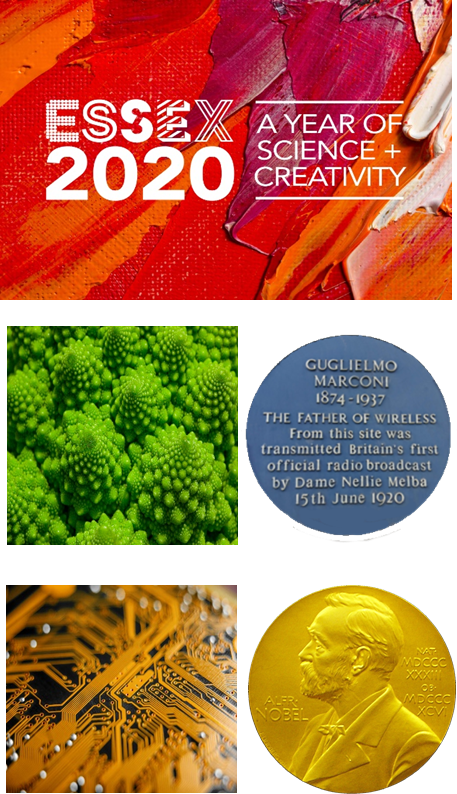 Deadline extended until 31 October!
Deadline extended until 31 October!
For our centenary year, 2020, we have worked with Essex County Council and Chelmsford City Council to celebrate Essex 2020 – a year of Science and Creativity – with hundreds of events being organised by a range of organisations and people.
This county-wide STEAM festival is putting the creative arts into STEM, and as part of this CSES is running a Centenary Photographic Competition open to primary and secondary students in Essex.
A visual celebration of Science and Engineering in Essex
 We want you to take and submit photographs which capture what is unique or special about science and technology from across our amazing county. From the longest pier in the world and the birthplace of radio, to Nobel prize winners, companies that put image sensors into space and much, much more...
We want you to take and submit photographs which capture what is unique or special about science and technology from across our amazing county. From the longest pier in the world and the birthplace of radio, to Nobel prize winners, companies that put image sensors into space and much, much more...
Take out your camera or your phone and get snapping! We are looking for visually appealing and original images that are inspiring and relevant to any aspect of Science, Technology, Engineering or Mathematics in Essex. We particularly want photos that are creative in their approach, with an innovative angle or a creative interpretation.
The competition is open to primary or secondary aged students living or educated in Essex. There are two categories of entry: one for primary school students and one for secondary school students. The entries will be shortlisted by members of CSES and a panel of judges will select a winner from the shortlisted entries in each category.
The prizes in each category are: 1st (£60 voucher), 2nd (£30 voucher) and 3rd (£20 voucher) place. The winners and selected entries will be displayed in an online exhibition and may feature in future publicity materials.
Send your photos (up to 3) as email attachment(s) to
Please put your full name, age and school / college name or home-educated status in the body of the email. You must include your name and the title of your image in each file name, separated by underscores (for example joan_smith_marconi_at_sunset). Feel free to provide a description if you like.
Entries must be submitted no later than Saturday 31 October 2020.
Winners will be announced in November.
Selected images may be made into a 2021 calendar and pictures may also be exhibited at Anglia Ruskin University and other locations. Entries will be displayed and used for marketing, with only first names used.
FAQs
How do I enter the photo competition? Please enter by email, following the instructions above. The last submission date is 25 September 2020.
Who can enter? Any primary or secondary aged student living or being taught (in school or at home) in Essex.
How many photos may I submit? Each entrant can submit a maximum of 3 images reflecting the STEAM theme.
How will my photograph be judged? Judging consists of two rounds for each category. In round one the judges will shortlist the best 10 images in each age group. The entries selected in round one will proceed to round two, where the judges will select a first, second and third place winner in each category.
When will the final winners be announced? The winners, and those who were shortlisted, will be notified by email between Monday 12 and Saturday 31 October.
What are the prizes? In each age category (primary and secondary): 1st prize £60 voucher, 2nd prize £35 voucher, 3rd prize £20 voucher. Winners and runners-up will be invited to an awards evening at the end of the academic year.
I’d like to enter a photo that has previously been in another competition. Is that allowed? You may not enter a photo that has previously been in another competition, but you may enter a photo that you are also submitting to this year's Chelmsford City Photo Competition.
Will my photographs be seen online? Some images may be published on the CSES website and our partner's websites.
Is image manipulation allowed in the photo contest? Yes, image manipulation is allowed.
When I submit a photo to the photo competition, what rights does CSES have to my image? CSES will have the nonexclusive, perpetual right to use your image in connection with the competition and promoting the Society, in any media now or in the future.
Are release forms required when submitting a photograph to the photo contest? By submitting a photograph, you are confirming that you are the owner of the image and the copyright. If your photograph contains an image of yourself or someone else, you must get your/their parent or guardian to submit a signed image consent form.
Still have a question? Email us at
Read on for full terms and conditions...

Note: deadline now 31 October 2020.
Terms and conditions
- Entrants must be of primary or secondary school age and must live and/or be educated within the County of Essex or the Unitary Authorities of Southend-on-Sea and Thurrock.
- The only images accepted will be digital photographs submitted by email. Previously published work not created specifically for the competition is not eligible.
- By submitting an image, the entrant declares that it is his/her own work and free of any copyright other than their own personal copyright. It is the responsibility of entrants to ensure that they do not infringe on the copyright or other rights of any third party.
- Copyright for the submitted images remains with their authors. However, by entering the competition, participants grant CSES permission to use their images online and/or in print for promotional purposes. We reserve the right to manipulate any images used in publicity and marketing material.
- If photos contain people, the entrant is responsible for gaining their consent and (if necessary) securing use their image free of copyright, fee or any other restriction. If your image contains the picture of anyone aged under 18 then you must submit an image consent form signed by their legal guardian.
- A maximum of 3 photos can be submitted per person.
- Photos will not be accepted into the competition if they are deemed inappropriate, this includes images that are offensive, previously published, copyrighted or deemed not to be in accordance with the theme of the competition.
- We will only consider entries submitted in the correct format by email before the specified deadline.
- Submit your entries by email to
This email address is being protected from spambots. You need JavaScript enabled to view it. . - Enter "CENTENARY PHOTO PRIMARY" or "CENTENARY PHOTO SECONDARY" (as appropriate) in the subject field of the email. In the body of the message, write your full name, age and school / college name or home-educated status.
- Images must be attached as JPEG/JPG files. Files must be no larger than 5 Mb and the longest edge of the image should be at least 1400 pixels. Enter your full name and the title of the image in the file name (for example joan_smith_marconi_at_sunset). Please use underscores as the separator.
- Prizes available in each category are as follows: 1st prize £60 voucher, 2nd prize £35 voucher, 3rd prize £20 voucher.
- Prizes will only be awarded subject to receiving a sufficient number of submissions at an appropriate standard of quality.
- CSES reserves the right to cancel the competition or alter the rules at any stage if circumstances arise outside of its control.
- There is no entry fee and no purchase necessary to enter this competition, but you will automatically be enrolled for free as a student member of CSES and receive information about our activities and events. You can opt-out of this at any time, including in your submission by stating so in your email.
- Our decision in respect of all matters to do with the competition will be final. This includes any judging decisions.
- The student winners' first names and schools/colleges (where appropriate) will be announced via our digital channels. If you do not wish for this data to be shared, please tell us in your email submission.
If you have any queries or questions please contact us at
Read on for tips on getting the best result out of your camera phone...
Tips for using camera phones
While you will get more control and better quality using a camera, smartphones have come a long way in the past few years and if you don't have the time or inclination to carry around a large camera, your smartphone (or even tablet) is often more than enough to get a great photo.
There are several websites that provide advice on how to make the most of photos taken with your phone. Try looking at this Beginners' Guide or Phone Photography 101.
Key things to remember are:
- Often better to turn the phone sideways and use two hands to take the picture as this minimises camera shake.
- If there is strong contrast in the scene (a light area and a dark area) or you find that you cannot get the sun behind you, the HDR (high dynamic range) setting will generally give a better image that is closer to what the eye sees. Note that this can mute the colours slightly and add a slight blur, so you may want to enhance the image afterward for best results.
- Use a tripod or some sort of support, even just someone's shoulder, and turn on the camera grid lines to help you align and compose the image. The best images typically have the main subject within one of the thirds of the frame.
- Try to get as much lighting, especially natural lighting (sunlight) as possible. The hours after sunrise and after sunset are usually the best light for photos but, in any case, use the phone camera flash as little as possible as it often does not improve the result.
- Use digital zoom as little as possible and probably never above 2x. Just get closer, or maybe try an add-on lens. The more you zoom in, the more unsteady the shot will become.
- If you find the built-in camera app on your phone is too basic or difficult to use, Google Camera is worth a look, and may give you more control of how the image turns out.
